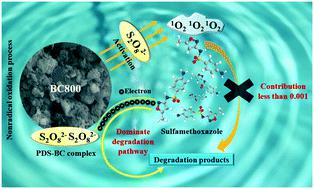当前位置:
X-MOL 学术
›
Environ. Sci.: Water Res. Technol.
›
论文详情
Our official English website, www.x-mol.net, welcomes your
feedback! (Note: you will need to create a separate account there.)
Electron transfer mechanism of peroxydisulfate activation by sewage sludge-derived biochar for enhanced degradation of sulfamethoxazole
Environmental Science: Water Research & Technology ( IF 3.5 ) Pub Date : 2021-06-14 , DOI: 10.1039/d1ew00279a Xuan-Yuan Pei 1 , Hong-Yu Ren 1 , De-Feng Xing 1 , Guo-Jun Xie 1 , Guang-Li Cao 1 , Jia Meng 1 , Nan-Qi Ren 1 , Bing-Feng Liu 1
Environmental Science: Water Research & Technology ( IF 3.5 ) Pub Date : 2021-06-14 , DOI: 10.1039/d1ew00279a Xuan-Yuan Pei 1 , Hong-Yu Ren 1 , De-Feng Xing 1 , Guo-Jun Xie 1 , Guang-Li Cao 1 , Jia Meng 1 , Nan-Qi Ren 1 , Bing-Feng Liu 1
Affiliation

|
There is an urgent need for the development of efficient and economical persulfate activators in persulfate-based advanced oxidation processes for wastewater treatment. Accordingly, in this work, sewage sludge from a wastewater treatment plant was carbonized at different pyrolysis temperatures in the range of 400–800 °C via a one-pot synthesis method, which was used to activate peroxydisulfate (PDS) for the degradation of sulfamethoxazole (SMX). Among the samples, biochar pyrolyzed at 800 °C (BC800) showed the best catalytic performance for the removal of SMX (85.3% in 60 min reaction). In the initial pH range of 5.0–11.0, PDS could be activated (0.75 g L−1) efficiently by BC800 for the degradation of SMX. Combined with electron paramagnetic resonance (EPR) spectroscopy, quenching experiment, steady-state kinetics experiment and electrochemical results, the degradation of SMX in the BC800/PDS system was proposed to be a degradation mechanism involving electron transfer as the main pathway. Through the analysis of the intermediates, the possible SMX degradation pathways were predicted. This study provides new insights into the mechanism for the sewage sludge-derived biochar activation of peroxydisulfate and its potential applications for the treatment of SMX wastewater.
中文翻译:

污水污泥衍生生物炭活化过二硫酸盐促进磺胺甲恶唑降解的电子转移机制
在用于废水处理的基于过硫酸盐的高级氧化工艺中,迫切需要开发高效且经济的过硫酸盐活化剂。因此,在这项工作中,来自废水处理厂的污水污泥通过一锅合成法在 400-800 °C 的不同热解温度下碳化,用于活化过二硫酸盐 (PDS) 以降解磺胺甲恶唑(SMX)。在样品中,在 800 °C 下热解的生物炭(BC800)表现出最好的去除 SMX 的催化性能(60 分钟反应 85.3%)。在 5.0-11.0 的初始 pH 范围内,PDS 可以被激活(0.75 g L -1) BC800 有效地降解 SMX。结合电子顺磁共振(EPR)光谱、猝灭实验、稳态动力学实验和电化学结果,提出SMX在BC800/PDS体系中的降解是一种以电子转移为主要途径的降解机制。通过对中间体的分析,预测了可能的 SMX 降解途径。这项研究为污水污泥衍生的生物炭活化过二硫酸盐的机制及其在 SMX 废水处理中的潜在应用提供了新的见解。
更新日期:2021-06-29
中文翻译:

污水污泥衍生生物炭活化过二硫酸盐促进磺胺甲恶唑降解的电子转移机制
在用于废水处理的基于过硫酸盐的高级氧化工艺中,迫切需要开发高效且经济的过硫酸盐活化剂。因此,在这项工作中,来自废水处理厂的污水污泥通过一锅合成法在 400-800 °C 的不同热解温度下碳化,用于活化过二硫酸盐 (PDS) 以降解磺胺甲恶唑(SMX)。在样品中,在 800 °C 下热解的生物炭(BC800)表现出最好的去除 SMX 的催化性能(60 分钟反应 85.3%)。在 5.0-11.0 的初始 pH 范围内,PDS 可以被激活(0.75 g L -1) BC800 有效地降解 SMX。结合电子顺磁共振(EPR)光谱、猝灭实验、稳态动力学实验和电化学结果,提出SMX在BC800/PDS体系中的降解是一种以电子转移为主要途径的降解机制。通过对中间体的分析,预测了可能的 SMX 降解途径。这项研究为污水污泥衍生的生物炭活化过二硫酸盐的机制及其在 SMX 废水处理中的潜在应用提供了新的见解。











































 京公网安备 11010802027423号
京公网安备 11010802027423号